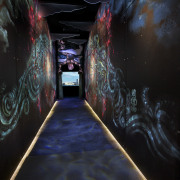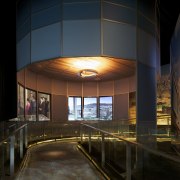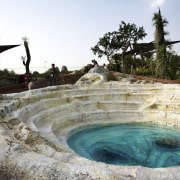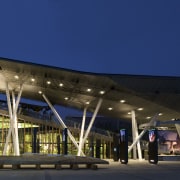a solid foundation
The New Zealand Pavilion at Shanghai World Expo 2010 is more than a retelling of a country's evolution it is a symbol of the relationship between two nations
As the most recently discovered land mass, New Zealand is often called the world's youngest country. Whether that term is strictly accurate is open to debate; however, it's undeniable that as a nation we've come a long way in a short time.
At Shanghai World Expo 2010, the rest of the world will have a chance to see how we Kiwis perceive ourselves when they visit the New Zealand Pavilion.
Designed by architects Warren and Mahoney, the pavilion is based around the theme Cities of Nature: Living between Land and Sky, and is informed by the belief that achieving a balance with nature and the environment is a vital part of successful modern city living, says design architect Blair Johnston.
"The pavilion has been designed to represent a slice of New Zealand landscape, transported to Shanghai. The folded roof plane references the proximity and connection between New Zealand's cities and the countryside, while promoting the idea that our urban and rural environments are balanced and sustainable."
The integral message is that life forces natural and human are not separate, but rather, different aspects of the same creative spirit.
"The New Zealand Pavilion is about authentic experiences and a key aspect of this is the concept of welcome. The invitation to enter is almost tangible, and appropriate to a young country that prides itself on its openness, warmth and transparency," says Johnston.
The task of designing, building and ultimately removing the New Zealand Pavilion for Shanghai World Expo 2010 was given to a consortium led by project management firm Coffey Projects, a subsidiary of Coffey International Limited.
"The pavilion needed to fulfil a dual role," says Chris Bicknell, project director for Coffey Projects. "It is primarily an exhibition experience, but it also needs to work as a functions venue and offices.
"To achieve a seamless integration of both roles, we focused on the overall visitor experience, designing the pavilion from the inside out. The design team, including architects Warren and Mahoney, worked collaboratively to ensure a cohesive and co-ordinated result."
One of the challenges of the project familiar to many New Zealand businesses was distance.
"With half the project team based in New Zealand and the other in Shanghai, it was important to select companies that had international experience, and good local relationships in Shanghai," says Bicknell.
"The New Zealand Pavilion project presented us with an invaluable opportunity to further develop our specialist project management skills, and to work with different cultures and markets. Its ultimate success will be testament to the collaborative nature inherent in the project from the very start."
With its proven international track record and an established local presence, Beca Carter Hollings & Ferner Limited (Beca) was an obvious partner choice of the New Zealand Pavilion at Shanghai World Expo 2010.
"Beca provided multidisciplinary engineering services, and ESD advice to the project," says Andrew Jackson, technical director building services.
"With the pavilion only operational for six months, the design of the structure needed to take into consideration its eventual deconstruction," says Rob Jury, technical director structural engineering. "The pavilion design, along with its construction, was required to conform to the dictates of the specific code established by the Local Design Institute, which covered the temporary utilisation of the buildings."
"Low-impact, cost-effective ESD features were also implemented to improve the quality of the building environment, reduce operating costs and promote New Zealand's sustainable image," says Jackson.
In all, Beca provided expertise in structural, electrical and mechanical engineering, fire and civil engineering, plumbing and drainage and sustainability services.
"Having a knowledge of local procedures and an international skill set meant Beca was able to work closely with everyone involved to ensure a best-practice outcome for the project," says Jackson.
Creating a visually arresting building is only half the story of the New Zealand Pavilion at Shanghai World Expo 2010. Once inside, visitors will be taken on a journey through a day-in-the-life of a Kiwi family. Making sure that journey is a cross-cultural success is Story Inc, the firm behind the renowned Lord of the Rings international touring exhibition.
"The visitor experience focuses on the constant presence of nature in New Zealand's urban life and the benefits it brings," says Dean Cato, director of Story Inc.
Starting with the plaza the physical manifestation of Rangi and Papa of the Maori creation myth visitors are welcomed by Chinese-speaking New Zealanders and kapa haka performers. Interactive pou, or totem poles, allow visitors to learn more about New Zealand before entering the pavilion. A 1.8-tonne greenstone boulder is the symbolic heart of the pavilion, which visitors can touch before passing through a waharoa depicting the Maori god Tane.
"After passing through the welcoming arms of Tane, visitors take a chronological journey from dawn to dusk that traverses the seasons and the New Zealand landscape," says Cato. "Set out over five stations, the story is punctuated by a series of four-sided screen towers, each depicting a different sequence, to provide each visitor with an individual look into New Zealand culture."
As the visitors make their way up the sloping walkway from station to station, the visuals are accompanied by a corresponding soundtrack.
At the end of the journey, which rises the height of the pavilion, visitors are greeted by a kaitiaki, or guardian, at the entrance to the rooftop garden.
The garden, designed by Kim Jarrett and Tina Hart of Dawnfinder, is composed of six main areas each presided over by a kaitiaki that take visitors on a return journey from the mountains to the sea.
At the start of the pathway is Gondwanaland, the ancient southern supercontinent filled with ponga from which New Zealand would eventually break free.
From there visitors will walk past a korokoro, a thermal lake, perhaps one of the most recognisable features of the landscape. According to Maori legend, korokoro are formed by Ruaumoko, god of the underworld and the youngest of Rangi and Papa's children.
Next is a forest valley, which in turn gives way to pasturelands, which emphasise New Zealand's agricultural industry. From there, visitors enter the South Pacific Sanctuary that features a planted arbour showcasing Maori weaving techniques and sub-tropical plants to highlight how New Zealanders have incorporated a regional dialect into their gardens.
The final stop on the descent is at a coastal area, where the iconic pohutukawa reigns supreme.
"New Zealand has plenty to contribute to Shanghai World Expo 2010, presenting itself as an innovative, environmentally conscious, multicultural, Asia-Pacific nation," says Phillip Gibson, New Zealand commissioner general, Shanghai World Expo 2010.
"New Zealand cities consistently score very highly in international ratings for quality of life, and Shanghai 2010 is a vital platform to showcase the very best of the country to China, and to the global community.
"Our two nations enjoy a long-standing and successful relationship, reinforced when New Zealand and China negotiated a free trade agreement in 2008," says Gibson.
"New Zealand's participation in Shanghai World Expo 2010 is a continuation of an involvement that began in 1851 with the World's Fair in London, and further cements our positive existing relationship with China and its people."
Credit list
Developer
Architect
Landscape design
Civil and structural engineering
Quantity surveyor
Fire services
Lighting
Exhibition fit out
Website
Project manager
Visitor experience
Technology design and integration
Fire and building services
Main contractor
Landscape contractor
Audiovisual
Steel supply
Website
Website
Story by: Justin Foote
Home kitchen bathroom commercial design
Natural is always in style
Stretching out to nature
Lean and green















